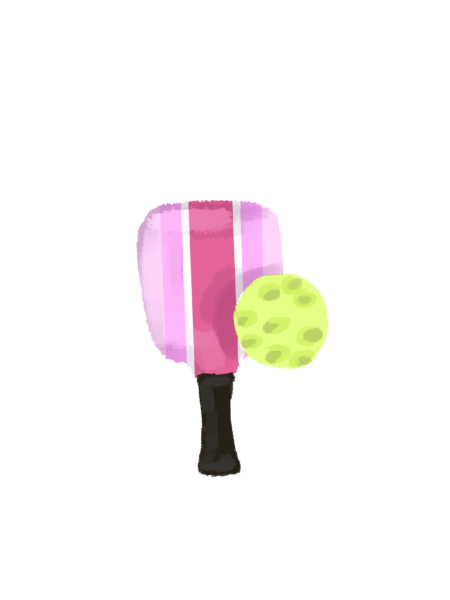Over the past few years, parkgoers may have noticed some new additions to the tennis courts near San Mateo and Foster City–bright pink miniature nets deployed over a dozen makeshift courts, adorned with shabby duct tape for lines. The Bay Area is not the only one jumping on the pickleball trend – after all, it’s been named the fastest growing sport in America by ESPN for the past four years. But why the national rage over pickleball.
For one, pickleball is very compact: paddles are small and light while nets can be rolled up and stored in a bag, and courts can be created just about anywhere with tape. This made pickleball the perfect candidate for a pandemic sport. People were stuck at home, often unable to participate in their usual sport due to facility restrictions, but had a lot of time and an open back yard.
“When Covid hit,… there was a big wave of people shifting over to pickleball,” said social studies teacher and tennis player Jon Felder. “Before Covid, I almost never saw anyone play [pickleball].”
One person who rode the pickleball surge after the pandemic is Chinese teacher and pickleball enthusiast Qi Fan. What was once a casual pastime with her friends now became an irreplaceable part of her routine.
“I’m addicted [to pickleball],” Fan said. “I hope this is a good addiction; I still support my family and my job as my priority, but I feel [pickleballers] have a shared interest, and that we’re a warm community, doing things together to make the community better. That’s a lofty thing.”
“I got started because I saw other people play, since my house is near the pickleball court,” Fan said. “When I walked my dog, I saw people playing pickleball, and it seemed fun. It doesn’t require a lot of sports background, a lot of training…[the] paddle seems small and light, unlike tennis which seems intimidating.”
By being so beginner-friendly, pickleball has drawn in both adults and teenagers alike.
“There’s no shame if you’re bad at it, because everyone’s learning together,” said junior Brooke Lau, who had her first encounter with pickleball last summer at a camp. “It’s a back and forth thing–you may lose one game, but then you could win the other, because your skills are basically on the same level.”
Pickleball’s strong retention of players is an indication of the potential it has.
“I’m addicted [to pickleball],” Fan said. “I hope this is a good addiction; I still support my family and my job as my priority, but I feel [pickleballers] have a shared interest, and that we’re a warm community, doing things together to make the community better. That’s a lofty thing.”

Pickleball’s low barrier to entry, diverse age groups, and small court makes it the perfect mecca to socialize with new people, and the pickleball community prides itself as being one of the friendliest across all sports.
“The pickleball community is really welcoming,” Lau said. “If you just go up and you’re like, ‘Hey, can I play with you guys’ and you’re by yourself, they’ll [say], ‘Oh, yeah’. The community is pretty good for making friends with new people.”
The tight-knit identity of the pickleball community also has an intensely passionate fanbase.
“One time Cupertino wanted to convert one of its pickleball courts over to a paid pickleball court,” Fan said. “But through collaborative effort, a lot of people showed up to City Hall on Zoom, and everyone talked about their pickleball story, how pickleball changed their lives. I think the government, the officials, were really touched. They did not expect to see so many people on Zoom. 500 people is a lot of people.”
Given pickleball’s meteoric rise in popularity, facilities have not been built fast enough to accommodate the influx of players.
“Since it’s so trendy right now, everyone’s playing,” Lau said. “No matter what time you go, the courts are always going to be filled. You have to wait so long just to get in one match and then it’s over. You have to wait another 20-30 minutes for your turn again.”
Looking for solutions to overcrowded pickleball courts, pickleballers take over empty tennis courts, much to the dismay of tennis players who feel the courts should be dedicated to tennis only.
“Some people who play tennis also play pickleball, so you get some crossover between the sports and they can go together,” Felder said. “The substitute [argument] would be if people are taking courts and there’s less space to play. But there might be a solution in the long run: they’re building pickle courts.”
While pickleball may be suffering from success as enthusiastic players struggle to find court space, it is the sport’s inclusive, social, and flexible nature that has captivated the hearts of many who tried it once and never dropped the paddle again.
The sport’s inclusive, social, and flexible nature has captivated the hearts of many who tried it once and never dropped the paddle again.



